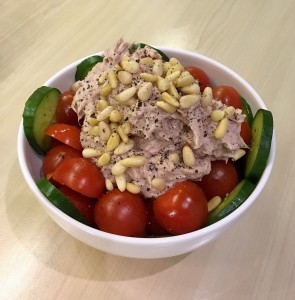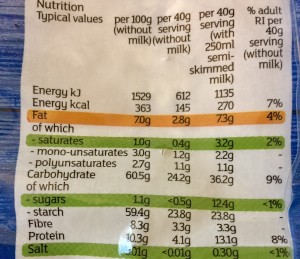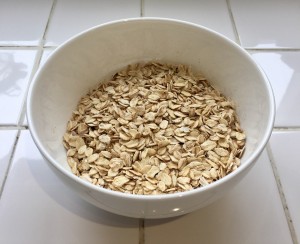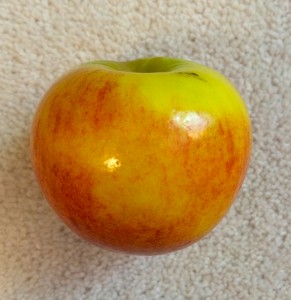
A Healthy Bowl? I can list the ingredients of my home made tuna and pine nut salad, but how many of us know what its nutrients are and how they affect the body?
The recent tragic deaths from eating insufficiently labelled Prêt à Manger food have highlighted two things. The obvious point is severely allergic people play Russian roulette with their lives every day, hoping food producers don’t inadvertently expose them to deadly allergens.
But the second point could prove damaging in the long term and it’s this: do you actually understand what food labels mean? When it says what it is on the tin, do you know what it does in practice?
And, as this could have consequences for your longevity and long-term quality of life, don’t you think we should know? More specifically, shouldn’t the government make sure we know?
I’ll give you a simple example. Take a label, picked at random, on the back of a packet of porridge. For the past few years, nutritionists have been urging people to eat oats for breakfast. They are full of energy, low in fat, fill you up, help lower cholesterol and ward off or control diabetes. But the label doesn’t say this. And what it does say is confusing.
There are five columns. The first breaks down five food groups (fats, carbohydrates, fibre, protein and salt) and then compares each with different portion sizes, milk types and quantity, and something called “% adult RI” of the smaller portion size without milk. Confused? Extremely.

Pick a Pack of Porridge: how much of what’s written on food nutrition labels do you read or fully understand?
For a start, I don’t weigh porridge. Nor do I know anyone who does. I follow the old fashioned method of cooking it, which is one cup of oats to a cup and a half of water. I have no idea how many grammes that is. I would have to turf out my scales from the back of the cupboard and then work out (i.e. guess) how much water I would need.
And what about people who add a banana or honey to their porridge? Or those who add butter or other types of fruit? Is this not allowed? And, by the way, where’s the warning for Coeliacs, as there is some debate about how their condition reacts to oats.
Meanwhile, there are also two numbers for energy so we hazard a guess “kcal” means calories. And then it’s maths time. As the 40-gramme serving (without milk) is 145 calories, what would the calories be if I had a cup full of oats with honey and a banana? And does 7% adult RI mean I’m part way to joining a Royal Institute? What happened to the letters RDA?! What happens if I can’t go online, or don’t have the time, to check this as I try to feed three under-fives at 6am?
And if that end figure actually means that my porridge is 7 out of 100 parts of the amount of energy I need every day, where do you suggest I get the rest? And why am I suddenly as an “adult” lumped in the same daily calorific requirement as my six-foot 17-stone partner when I’m five-foot-six and 8½ stone?
And could I just eat porridge all day to make up my calories? The answer is “yes” but nutritionally you’d be deprived of other essential vitamins and minerals, but you don’t know this, as they’re not listed. And, aside from knowing vitamin C prevents scurvy, do most people know what the rest of them do anyway? Do we even know what scurvy is these days?

Oat Cuisine: High in energy and low in salt, did you know oats also contain vitamins and minerals essential to health?
A little research reveals there are six vitamins present in oats, particularly B1 (thiamine, which is essential in energy production and, among a host of other vital measures, helps prevent beri beri) and to a lesser extent B5 (pantothenic acid, also essential for metabolism and maintaining normal blood sugar levels).
There are also seven minerals, especially manganese (essential for metabolism, forming the thyroid hormone and promoting fertility) and then phosphorus (which is part of the structure of our DNA, maintains teeth and bones, and helps in energy production). Though it does say there’s no salt (sodium).
Yet this label does not show the vitamin and mineral content of these oats – even though they keep us alive and healthy. Shouldn’t we be listing these vital components and what they do? Why have I had to look all this up? Why aren’t we learning this stuff in school?!
We aren’t facing an obesity crisis. We’re facing an obesity time bomb. Globally. We are stressed, working longer sedentary hours, pushed for time and inured to fast, cheap and easily available processed food that’s nutritionally poor and loaded with salt, sugar and bad fats. The NHS is creaking under the six-billion-pound bill obesity costs it.
Jamie Oliver went into school canteens and revolutionised school dinners. We need nutritionists to go into schools to teach kids what they need to eat – and why – to stay alive and in good health. And from day one. A is for apple.

A is for Apple: this readily available fruit is a super source of eight essential vitamins and minerals
If we don’t have enough nutritionists and teachers who can show kids how to cook, then train them. Invest in them. Encourage students to study food science. Over a quarter of the UK’s adult population has a degree but the nation’s nutritional knowledge seems almost Stone Age, and the ramifications are grave.
In a government paper on 31st March last year, Public Health England pulled no punches. “Obesity has a serious impact on economic development. The overall cost of obesity to wider society is estimated at £27 billion.
“The UK-wide NHS costs attributable to (being) overweight and obesity are projected to reach £9.7 billion by 2050, with wider costs to society estimated to reach £49.9 billion per year.”
The costs are staggering. As a nation, we can’t afford to throw this money away on a pandemic that is totally preventable. If we pay for this, how do we pay for our elderly and infirm? While the human toll of premature death and living with invalidity cannot be underestimated.
Education is the key to our very survival. Start with the young, so start with social media. Just one healthy tweet and Facebook and Instagram post every day could save lives. For adults over 25, offer tax breaks for regular gym users. And please, please, please give us clear, relevant and visible nutritional advice on food packaging, with suggested all-day meal plans for a balanced diet.
The stop smoking campaign is helping make lighting up a thing of the past. Education, legislation, heavy taxes and graphic advertising have all helped turn what was once a social norm into an antisocial vice. And it starts at the top.
I urge the government to kick-start an urgent, uncompromising nationwide education and PR campaign to help people to help themselves – which will ultimately save the state billions in pounds and people decades in years.
And do it now.

Comments are closed.